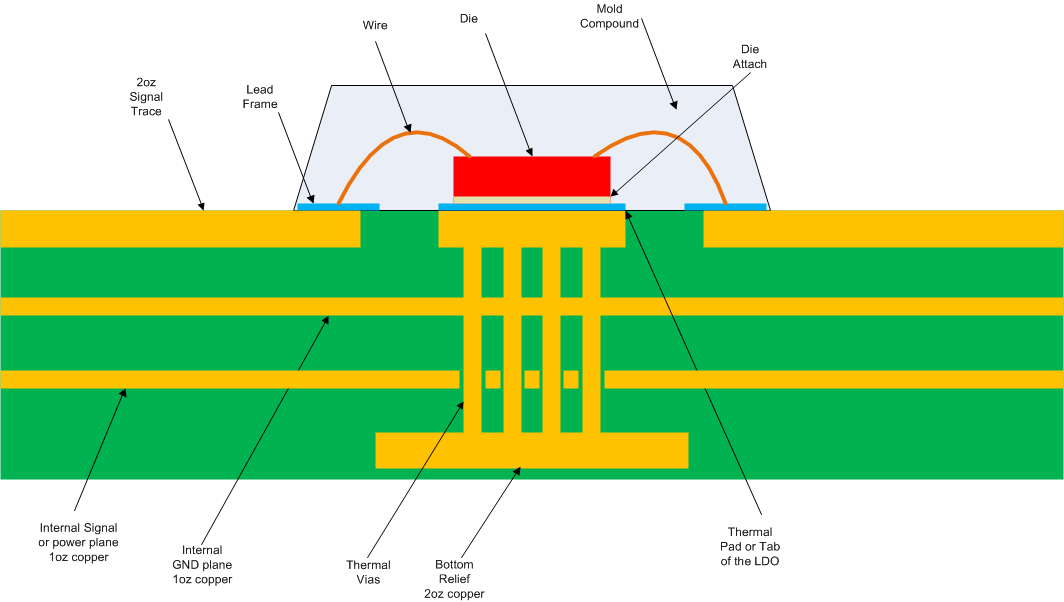JAJSN03A june 2022 – august 2023 TPS7B4255-Q1
PRODUCTION DATA
- 1
- 1 特長
- 2 アプリケーション
- 3 概要
- 4 Revision History
- 5 Pin Configuration and Functions
- 6 Specifications
-
7 Detailed Description
- 7.1 Overview
- 7.2 Functional Block Diagram
- 7.3 Feature Description
- 7.4 Device Functional Modes
- 8 Application and Implementation
- 9 Device and Documentation Support
- 10Mechanical, Packaging, and Orderable Information
パッケージ・オプション
メカニカル・データ(パッケージ|ピン)
サーマルパッド・メカニカル・データ
発注情報
8.4.1.4 Thermal Performance Versus Copper Area
The most used thermal resistance parameter RθJA is highly dependent on the heat-spreading capability built into the particular PCB design, and therefore varies according to the total copper area, copper weight, and location of the planes. The RθJA recorded in the Thermal Information table is determined by the JEDEC standard (Figure 8-5), PCB, and copper-spreading area, and is only used as a relative measure of package thermal performance. For a well-designed thermal layout, RθJA is actually the sum of the package junction-to-case (bottom) thermal resistance (RθJCbot) plus the thermal resistance contribution by the PCB copper.
 Figure 8-5 JEDEC Standard 2s2p
PCB
Figure 8-5 JEDEC Standard 2s2p
PCBFigure 8-6 through Figure 8-9 illustrate the functions of RθJA and ψJB versus copper area and thickness for the DBV package and DYB package. These plots are generated with a 101.6-mm × 101.6-mm × 1.6-mm PCB of two and four layers. For the 4-layer board, inner planes use 1-oz copper thickness. Outer layers are simulated with both 1-oz and 2-oz copper thickness. A 4 × 5 (DBV and DYB package) array of thermal vias with a 300-µm drill diameter and 25-µm copper plating is located as close as practical to the GND pin of the device. The thermal vias connect the top layer, the bottom layer and, in the case of the 4-layer board, the first inner GND plane. Each of the layers has a copper plane of equal area. The PowerPAD™ Thermally Enhanced Package application note discusses the impact that thermal vias have on thermal performance.
As shown in Figure 8-7, ψJB increases with additional connecting copper area. The reason for this increase is that the board temperature is measured at the copper near the GND pin, and because the GND pin is fused to the die pad, more heat escapes through the GND pin when more copper is connected to the pad, and thus the temperature at this point is higher. Consequently the ψJB increases. This increase does not imply that heat sinking for the device is reduced when more connecting copper is added. Increasing connecting copper area always increases board-level heat sinking for the device. Furthermore, the boards used for Figure 8-7 have vias connecting to internal copper planes. Therefore, ψJB is much higher than what is specified in the Thermal Information table, which uses the high-K board layout specified in JESD51-7 that has no thermal vias.
 Figure 8-6 RθJA vs Copper
Area (DBV Package)
Figure 8-6 RθJA vs Copper
Area (DBV Package) Figure 8-8 RθJA vs Copper
Area (DYB Package)
Figure 8-8 RθJA vs Copper
Area (DYB Package) Figure 8-7 ψJB vs Copper
Area (DBV Package)
Figure 8-7 ψJB vs Copper
Area (DBV Package) Figure 8-9 ψJB vs Copper
Area (DYB Package)
Figure 8-9 ψJB vs Copper
Area (DYB Package)